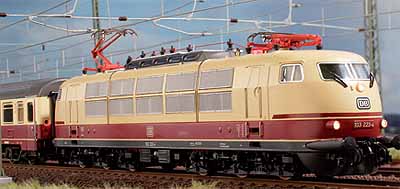Roco Modelleisenbahn
Roco’s masterful models
Producing locomotives, wagons, tracks, and accessories, Modelleisenbahn GmH was founded in July 2005, continuing over 40 years of Roco’s association with the model train industry.
Boasting a range of over 240 locomotives and 350 wagons, the company’s models are internationally renowned for their attention to detail and pioneering design.
The origins of the Roco brand date back to 1960, when Heinz Rössler founded a company under his own name with the intention of using plastic injection moulding to produce detailed military models. After finding strong success in the US, these minitanks were followed by Roco wagons, with HO, O and N gauge models produced in 1966. The next year, Roco entered the European market with its first HO models, finding success due to its high quality and economical pricing.
Gradually expanding its business, the company added a sales company in Germany in 1977 and a production company in Slovakia in 1993, before being sold to P. Maegdefrau in 2002. After Roco Modellspielwaren GmbH was declared bankrupt, the new company was founded in 2005 to continue the Roco name, and has since found great success, becoming one of the largest manufacturers of HO and N scale models in the world.
Describing the manufacturer’s current facilities, MD Leopold Heher says: “We are headquartered in Salzberg, where we have our sales and marketing, development, construction, finance and purchasing departments. We also have another Austrian facility in Gloggnitz, which handles tooling and moulding, while we have further plants in Slovakia and Romania, which paint, print and assemble.” The heart of the mould production is located in Gloggnitz, with ultra modern machinery used to produce the moulds for die-casting locomotives and wagons. Production is located in Banska Bystrica, central Slovakia, with the site manufacturing DC and AC locomotives, wagons and coaches, as well as plastic military models of the minitanks product line.
Detailing the recent addition of the Romanian facility, Leopold comments: “The company was founded in May 2006 with production commencing in June. Based in Arad, it currently employs 61 well trained and efficient employees, who are highly motivated and driven to perform to the highest quality standards.”
At all of the sites highly qualified technicians are employed to work on the prototypically accurate models. After recent investments in modernising the operations, production is performed using the latest technology, and as a result the unique products are synonymous with the highest possible standards in detailing, scale accuracy and precision, demonstrating the company’s passion for model railways.
A fine example of this is its model of the Austrian 310.23 steam locomotive, which features such high levels of precise detailing that it seems as if each model was individually handcrafted, with the almost silent Roco motor enhancing the overall quality of the train. Under its digital operation, the speed can even be reduced to where forward motion is almost imperceptible, including inclines. Asked what Roco’s key selling points are, Leopold replies: “All of our models are developed and produced true to the original. We offer a high quality product range and logistic performance, a price-performance ratio that is much stronger than our competitors, and release new developments much more regularly.”
With approximately 250 varieties of colour and shape developed each year, 40 per cent of the company’s turnover is represented by its latest releases. Research and development has been a key focus throughout Roco’s history and as a result the company has set a number of milestones that have made a lasting impact on the model railway industry. One particular innovation it promoted was short-coupling, while its LINE track system allowed enthusiasts to accurately create scaled gravel roadbed tracks for the first time, through innovative scaling, robustness and reliability.
Recently digital technology has had a significant impact on the market, with Roco helping to pioneer the development of digital cranes, couplings and turnouts. “We began digital model train technology in 1994, and today the focus of our innovations is on digital elements, engine units and track systems,” explains Leopold. “Although, alongside our digital systems, which have many more functions, a better price-performance ratio and ergonomic shape than our competitors, we also still offer our track system, which is easier to assemble and handle, and is approximately 30 per cent cheaper that the competition.”
Discussing the overall condition of the company’s markets, Leopold continues: “Our key markets, which include Austria, Germany and Switzerland have experienced little growth, however other markets in Western Europe and Eastern Europe have a high potential for growth as the market coverage is still poor. Helping to aide our expansion in these areas is our international product range and our manufacturing facilities in Eastern Europe, and we hope to see our turnover continue to grow by five per cent each year.”
With Roco Modelleisenbahn’s first quarter of 2007 seeing a 30 per cent rise in incoming orders, the company is benefiting from its investment in research and development, and as a renowned manufacturer of high precision locomotives, increasing numbers of adults and children alike are playing and collecting the top quality models.
Roco Modelleisenbahn
Products:
Model Trains
Sites:
Austria, Slovakia and Romania
Employees: 560
www.roco.cc
